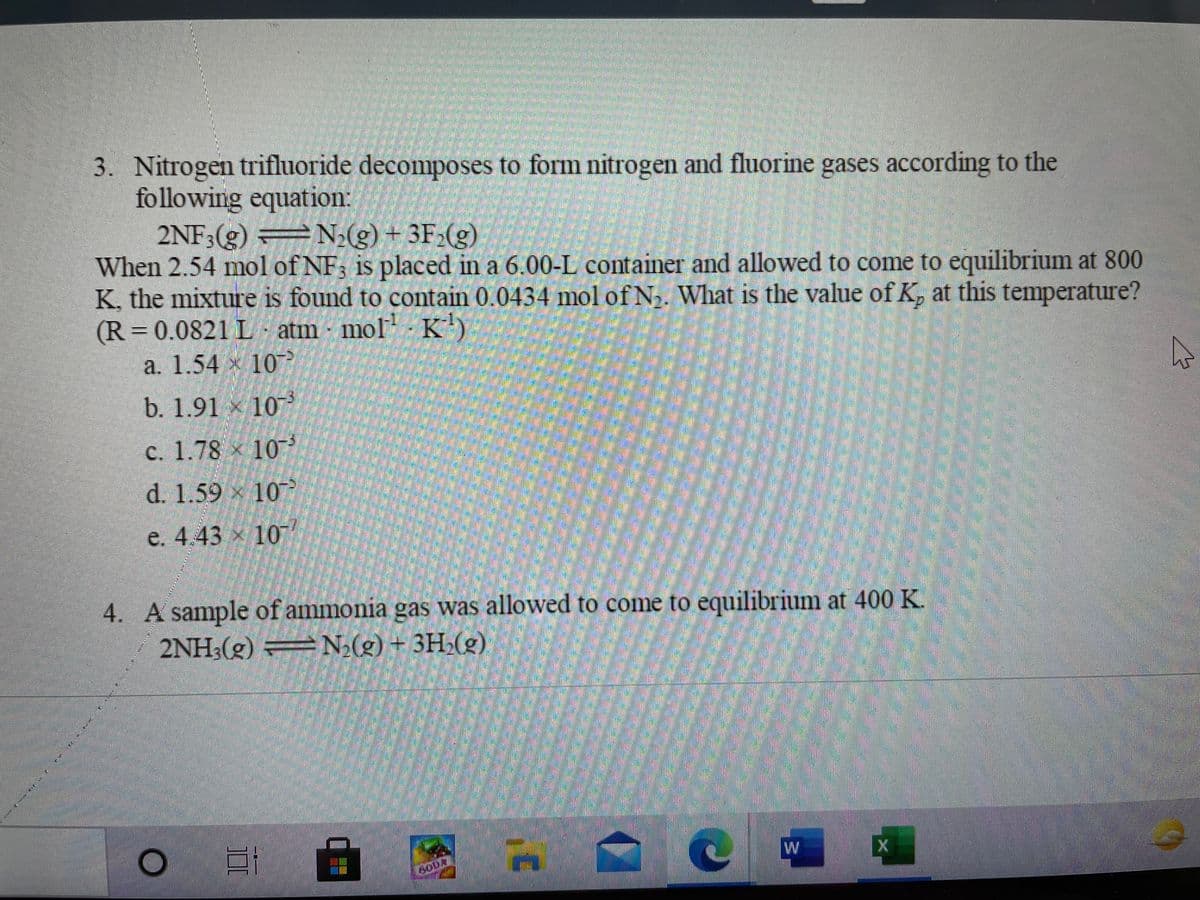3. Nitrogen trifluoride decomposes to form nitrogen and fluorine gases according to the following equation: 2NF3(g) = N(g)+ 3F2(g) When 2.54 mol of NF; is placed in a 6.00-L container and allowed to come to equilibrium at 800 K, the mixture is found to contain 0.0434 molof N. What is the value of K, at this temperature? (R = 0.0821 L atm - mol - K') a. 1.54 x 10 %3D b. 1.91 × 10 c. 1.78 x 10* d. 1.59 x 10 e. 4.43 x 10
3. Nitrogen trifluoride decomposes to form nitrogen and fluorine gases according to the following equation: 2NF3(g) = N(g)+ 3F2(g) When 2.54 mol of NF; is placed in a 6.00-L container and allowed to come to equilibrium at 800 K, the mixture is found to contain 0.0434 molof N. What is the value of K, at this temperature? (R = 0.0821 L atm - mol - K') a. 1.54 x 10 %3D b. 1.91 × 10 c. 1.78 x 10* d. 1.59 x 10 e. 4.43 x 10
General Chemistry - Standalone book (MindTap Course List)
11th Edition
ISBN:9781305580343
Author:Steven D. Gammon, Ebbing, Darrell Ebbing, Steven D., Darrell; Gammon, Darrell Ebbing; Steven D. Gammon, Darrell D.; Gammon, Ebbing; Steven D. Gammon; Darrell
Publisher:Steven D. Gammon, Ebbing, Darrell Ebbing, Steven D., Darrell; Gammon, Darrell Ebbing; Steven D. Gammon, Darrell D.; Gammon, Ebbing; Steven D. Gammon; Darrell
Chapter18: Thermodynamics And Equilibrium
Section: Chapter Questions
Problem 18.124QP: Hydrogen gas and iodine gas react to form hydrogen iodide. If 0.500 mol H2 and 1.00 mol I2 are...
Related questions
Question

Transcribed Image Text:3. Nitrogen trifluoride decomposes to form nitrogen and fluorine gases according to the
following equation:
2NF3(g) =N(g) + 3F>(g)
When 2.54 mol of NF; is placed in a 6.00-L container and allowed to come to equilibrium at 800
K, the mixture is found to contain 0.0434 mol of N. What is the value of K, at this temperature?
(R = 0.0821 L atm mol K')
a. 1.54 x 10
b. 1.91 × 10
c. 1.78 × 10-
d. 1.59 x 10
e. 4.43 x 10
4. A sample of ammonia gas was allowed to come to equilibrium at 400 K.
2NH3(g)
=N(g)+ 3H2(g)
Expert Solution
This question has been solved!
Explore an expertly crafted, step-by-step solution for a thorough understanding of key concepts.
This is a popular solution!
Trending now
This is a popular solution!
Step by step
Solved in 2 steps

Knowledge Booster
Learn more about
Need a deep-dive on the concept behind this application? Look no further. Learn more about this topic, chemistry and related others by exploring similar questions and additional content below.Recommended textbooks for you

General Chemistry - Standalone book (MindTap Cour…
Chemistry
ISBN:
9781305580343
Author:
Steven D. Gammon, Ebbing, Darrell Ebbing, Steven D., Darrell; Gammon, Darrell Ebbing; Steven D. Gammon, Darrell D.; Gammon, Ebbing; Steven D. Gammon; Darrell
Publisher:
Cengage Learning

Chemistry: Principles and Reactions
Chemistry
ISBN:
9781305079373
Author:
William L. Masterton, Cecile N. Hurley
Publisher:
Cengage Learning

Chemistry: An Atoms First Approach
Chemistry
ISBN:
9781305079243
Author:
Steven S. Zumdahl, Susan A. Zumdahl
Publisher:
Cengage Learning

General Chemistry - Standalone book (MindTap Cour…
Chemistry
ISBN:
9781305580343
Author:
Steven D. Gammon, Ebbing, Darrell Ebbing, Steven D., Darrell; Gammon, Darrell Ebbing; Steven D. Gammon, Darrell D.; Gammon, Ebbing; Steven D. Gammon; Darrell
Publisher:
Cengage Learning

Chemistry: Principles and Reactions
Chemistry
ISBN:
9781305079373
Author:
William L. Masterton, Cecile N. Hurley
Publisher:
Cengage Learning

Chemistry: An Atoms First Approach
Chemistry
ISBN:
9781305079243
Author:
Steven S. Zumdahl, Susan A. Zumdahl
Publisher:
Cengage Learning

Chemistry
Chemistry
ISBN:
9781305957404
Author:
Steven S. Zumdahl, Susan A. Zumdahl, Donald J. DeCoste
Publisher:
Cengage Learning


Chemistry for Engineering Students
Chemistry
ISBN:
9781337398909
Author:
Lawrence S. Brown, Tom Holme
Publisher:
Cengage Learning